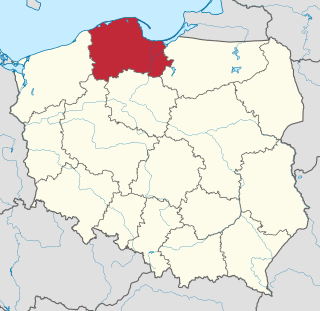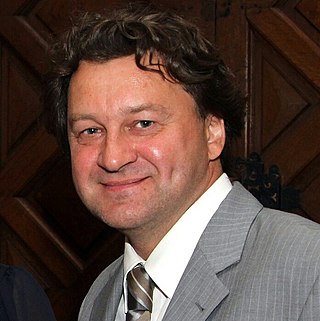
Pomerania is a historical region on the southern shore of the Baltic Sea in Central Europe, split between Poland and Germany. The central and eastern part belongs to the West Pomeranian, Pomeranian and Kuyavian-Pomeranian voivodeships of Poland, while the western part belongs to the German states of Mecklenburg-Western Pomerania and Brandenburg.

Włocławek is a city in the Kuyavian–Pomeranian Voivodeship in central Poland along the Vistula River, bordered by the Gostynin-Włocławek Landscape Park. As of December 2021, the population of the city is 106,928.

Pomeranian Voivodeship is a voivodeship, or province, in northwestern Poland. The provincial capital is Gdańsk.

Kociewie is an ethnocultural region in the eastern part of Tuchola Forest, in northern Poland, Pomerania, that is inhabited by the Kociewians. Its cultural capital is Starogard Gdański, the biggest town is Tczew, while other major towns include Świecie, and Pelplin. The region has about 250,000 inhabitants. It has well-developed industry and agriculture. Administratively, it is divided between the Pomeranian and Kuyavian-Pomeranian Voivodeships.

Jarosław Kukowski is a Polish contemporary painter, juror of international art competitions. His works were exhibited, among others Branch Museum of the National-Królikarnia Salons Rempex Auction House, the Museum of Galicia, the Contemporary Art Gallery, Castle Voergaard, the Art Expo New York and many other galleries and museums in the world. He is considered one of the most influential contemporary creators of the Surrealist circle.

A Ratusz is a historic administrative building in countries that adopted the Magdeburg rights such as the Holy Roman Empire, Polish–Lithuanian Commonwealth and others. It was distinguished with a bell tower. Unlike a regular city hall which may or may not have any specific architectural compositions, ratusz (rathaus) always consisted of a building with a tower.

The Gothic architecture arrived in Poland in the first half of the 13th century with the arrival of the Dominican and Franciscan orders. The first elements of the new style are evident in the foundation of the Dominican Trinity church in Kraków (1226–1250), built by Bishop Iwo Odrowąż. Rebuilding of the Wrocław Cathedral, started in 1244, was another early manifestation of the Gothic style. The earliest building in Poland built entirely in the Gothic style is the chapel of St. Hedwig in Trzebnica (1268–1269), on the grounds of a Cistercian monastery.

Pelplin is a town in northern Poland, in the Tczew County, Pomeranian Voivodship. Population: 8,320 (2009).

The Diocese of Chełmno was a Catholic diocese in Chełmno Land, founded in 1243 and disbanded in 1992.

Toruń Regional Museum, located in the Ratusz hall of Toruń, is one of the oldest and largest museums in Poland. It started in 1594 as the mere Cabinet of Curiosities at the library of the academic Gimnazjum, called Musaeum in Latin. Re-established in sovereign Poland as a city museum in 1920 after the century of military partitions, it was administratively structured as the regional museum in 1965.

Kłanino is a village in the administrative district of Gmina Krokowa, within Puck County, Pomeranian Voivodeship, in northern Poland. It lies approximately 6 kilometres (4 mi) east of Krokowa, 13 km (8 mi) north-west of Puck, and 51 km (32 mi) north-west of the regional capital Gdańsk.
Kulice is a village in the administrative district of Gmina Pelplin, within Tczew County, Pomeranian Voivodeship, in northern Poland. It lies approximately 5 kilometres (3 mi) south of Pelplin, 25 km (16 mi) south of Tczew, and 54 km (34 mi) south of the regional capital Gdańsk. It is located within the ethnocultural region of Kociewie in the historic region of Pomerania.

Rożental is a village in the administrative district of Gmina Pelplin, within Tczew County, Pomeranian Voivodeship, in northern Poland. It lies approximately 2 kilometres (1 mi) south-west of Pelplin, 21 km (13 mi) south of Tczew, and 51 km (32 mi) south of the regional capital Gdańsk. It is located within the ethnocultural region of Kociewie in the historic region of Pomerania.
Szpęgawa is a village in the administrative district of Gmina Tczew, within Tczew County, Pomeranian Voivodeship, in northern Poland. It lies approximately 2 kilometres (1 mi) east of Tczew and 31 km (19 mi) south of the regional capital Gdańsk. It is located within the ethnocultural region of Kociewie in the historic region of Pomerania.

The Jakub Wujek Bible was the main Polish Bible translation used in the liturgy of the Roman Catholic Church in Poland from the late 16th century till the mid-20th century.

The architecture of Poland includes modern and historical monuments of architectural and historical importance.

The earliest Bible translations into Polish date to the 13th century. The first full ones were completed in the 16th.

Giennadij Jerszow is a Polish–Ukrainian sculptor, jewelry designer and art teacher. He is a member of the National Union of Artists of Ukraine, and the National Association of Polish Artists and Designers. He is known for the production of monumental works, easel compositions and portraits, represented in different countries.

The Beautiful Madonna from Toruń - a Gothic sculpture depicting Mary and Infant Jesus. One of the most valuable, in terms of artistic value, images of the Madonna and Child made at the turn of the 14th and 15th century. In terms of typology and stylistics, this work is pars pro toto of the Beautiful Madonna, an iconographic type shaped before 1400. The sculpted images of Beautiful Madonnas represent the Beautiful style, a stylistic trend shaped during the Gothic period in Central Europe.

Saint Luke painting the Virgin is a c.1510 International Gothic limewood relief sculpture, probably carved by Jakub Beinhart and now in the National Museum, Warsaw. It is the only surviving fragment of an altarpiece for the painters' guild chapel in St Mary Magdalene Church, Wrocław, formerly forming its central panel.





























